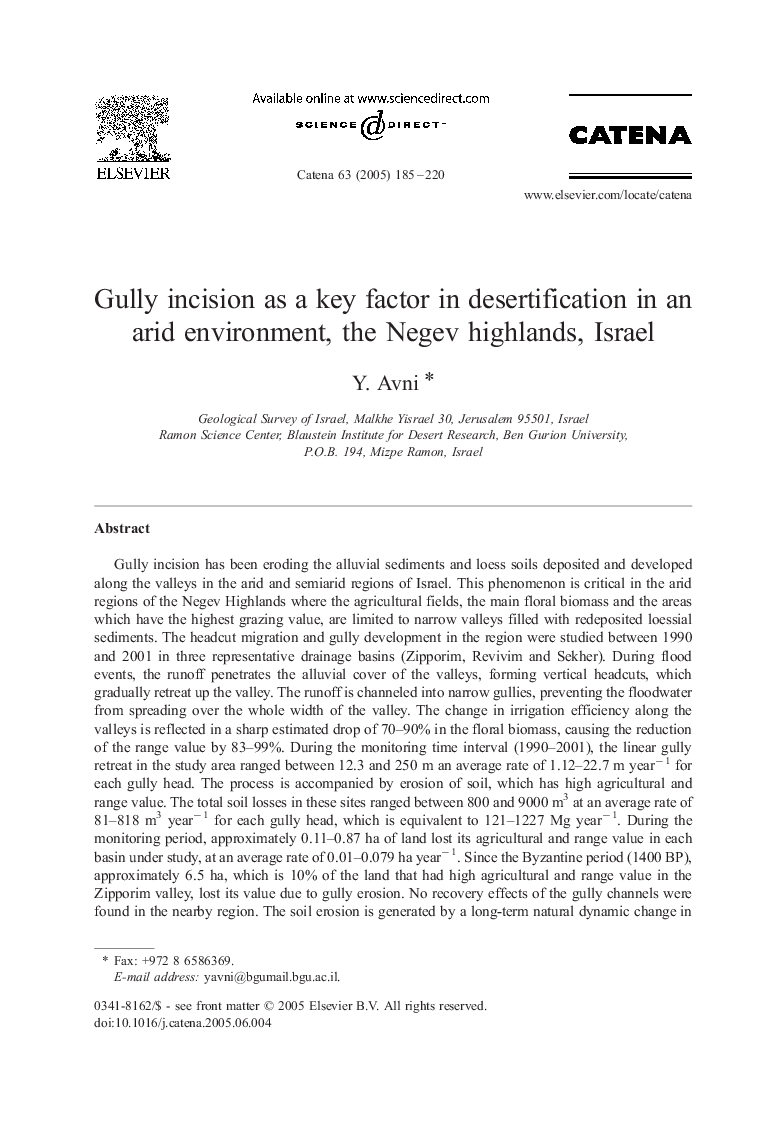| کد مقاله | کد نشریه | سال انتشار | مقاله انگلیسی | نسخه تمام متن |
|---|---|---|---|---|
| 9489936 | 1629270 | 2005 | 36 صفحه PDF | دانلود رایگان |
عنوان انگلیسی مقاله ISI
Gully incision as a key factor in desertification in an arid environment, the Negev highlands, Israel
دانلود مقاله + سفارش ترجمه
دانلود مقاله ISI انگلیسی
رایگان برای ایرانیان
موضوعات مرتبط
مهندسی و علوم پایه
علوم زمین و سیارات
فرآیندهای سطح زمین
پیش نمایش صفحه اول مقاله

چکیده انگلیسی
Gully incision has been eroding the alluvial sediments and loess soils deposited and developed along the valleys in the arid and semiarid regions of Israel. This phenomenon is critical in the arid regions of the Negev Highlands where the agricultural fields, the main floral biomass and the areas which have the highest grazing value, are limited to narrow valleys filled with redeposited loessial sediments. The headcut migration and gully development in the region were studied between 1990 and 2001 in three representative drainage basins (Zipporim, Revivim and Sekher). During flood events, the runoff penetrates the alluvial cover of the valleys, forming vertical headcuts, which gradually retreat up the valley. The runoff is channeled into narrow gullies, preventing the floodwater from spreading over the whole width of the valley. The change in irrigation efficiency along the valleys is reflected in a sharp estimated drop of 70-90% in the floral biomass, causing the reduction of the range value by 83-99%. During the monitoring time interval (1990-2001), the linear gully retreat in the study area ranged between 12.3 and 250 m an average rate of 1.12-22.7 m yearâ 1 for each gully head. The process is accompanied by erosion of soil, which has high agricultural and range value. The total soil losses in these sites ranged between 800 and 9000 m3 at an average rate of 81-818 m3 yearâ 1 for each gully head, which is equivalent to 121-1227 Mg yearâ 1. During the monitoring period, approximately 0.11-0.87 ha of land lost its agricultural and range value in each basin under study, at an average rate of 0.01-0.079 ha yearâ 1. Since the Byzantine period (1400 BP), approximately 6.5 ha, which is 10% of the land that had high agricultural and range value in the Zipporim valley, lost its value due to gully erosion. No recovery effects of the gully channels were found in the nearby region. The soil erosion is generated by a long-term natural dynamic change in the soil / rock ratio evolving within the drainage basins through time since the termination of the last glacial phase. The loessic sediments, originally deposited within the drainage basins during the late Pleistocene glacial stage, are being removed under the present Holocene climate in several erosion stages. This ongoing phenomenon is causing degradation of soil and biomass and is severely reducing the agricultural and range potential of the region. These parameters indicate that an ongoing process of desertification is active in the arid environment of the Negev Highlands, and is advancing in proportion to the headcut retreat rates in the region. The soil erosion and headcut retreat have been active in the Negev Highlands for the last few millennia. If these processes continue in the future, the Negev Highlands region will lose its agricultural potential within a few millennia. However, the fact that the ancient inhabitants of the region implemented successful long-term land conservation techniques already 3000 years ago, implies that a sustainable land management policy can be adapted to the Negev Highlands, as well as to other semi-arid regions in the Middle East.
ناشر
Database: Elsevier - ScienceDirect (ساینس دایرکت)
Journal: CATENA - Volume 63, Issues 2â3, 31 October 2005, Pages 185-220
Journal: CATENA - Volume 63, Issues 2â3, 31 October 2005, Pages 185-220
نویسندگان
Y. Avni,